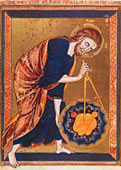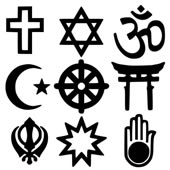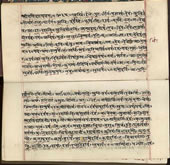

|

|

|

|

|

|

|

|
|
~~~~~~ World Bibliography of Beliefs, Theories and Theologies ~ click pix to enlarge ~~~~~~ Christianity and other religions Christianity and other religions appear to share some elements. In a look at Christianity’s relationship with other world religions, this article investigates the differences and similarities of Christianity to other religions. Relationship with Judaism See also: Christianity and Judaism and Judeo-Christian Historically, the relationship between Christianity and Judaism has been strained, to say the least. In the past, Christians were often taught that "the Jews" killed Christ, see Responsibility for the death of Jesus, for which "murder" they bear a collective guilt (an interpretation which most major denominations now reject). Jews meanwhile have tended to associate Christianity with various pogroms, or in better times, with the dangers of assimilation. Anti-Semitism has a long history in Christianity (see Christianity and anti-Semitism), and indeed is far from dead (for example, in contemporary Russia). However, since the Holocaust, much dialogue aimed at Christian-Jewish reconciliation has taken place, and relations have greatly improved. Today, many conservative evangelicals support Christian Zionism, much to the irritation of Arab Christians, based partly on the Millenialist belief that the modern state of Israel represents the fulfillment of Biblical prophecy. |

|

|

|

|

|

|
|
The phenomenon of Messianic Judaism has become something of an irritant to Jewish/Christian relations. Messianic Jews--who generally seek to combine a Jewish identity with the recognition of Jesus-- are rejected by mainstream Jewish groups, who dismiss Messianic Judaism as little more than Christianity with Jewish undertones. The Jewish conception of the messiah ("mashiach" in Hebrew) holds certain similarities to that of Christians, yet there are substantial differences. According to Jews, the Hebrew Scriptures contain a small number of prophecies concerning a future descendant of King David, who will be anointed (Hebrew: moshiach) as the Jewish people’s new leader and will establish the throne of David in Jerusalem forever. In the Jewish view, this fully human and mortal leader will rebuild the land of Israel and restore the Davidic Kingdom. This subject is covered in the section on Jewish eschatology. Christians have a different understanding of the term messiah, and believe that Jesus is the messiah referred to in the Old Testament prophecies; that the kingdom in these prophecies was to be a heavenly kingdom, not an earthly one; and that Jesus’ words and actions in the New Testament provide evidence of his identity as messiah. Relationship with Islam See also: Christianity and Islam and Christian view of Muhammad Islam shares a number of beliefs with Christianity. They share similar views on monotheism, judgment, heaven, hell, spirits, angels, and a future resurrection. Jesus is acknowledged and respected by Muslims as a great prophet. However, while Islam relegates Jesus to a lesser status than God - "in the company of those nearest to God" in the Qur’an, mainstream (Trinitarian) Christianity believes quite firmly and without question that Jesus is God the Son, one of the three Hypostases (common English: persons) of Christianity’s Holy Trinity, equally God as are God the Father and the Holy Spirit. However, an Islamic parallel to the Christian Trinity could be seen in the 99 Beautiful Names of God, which represent distinctly manifest qualities of the One God (Allah), rather than ninety-nine distinct gods. The religions both share a belief in the virgin birth of Jesus, his miracles and healings, and that he ascended bodily into heaven. However, Jesus is not accepted as the Person of the Son within the Trinity by Muslims, except in the sense of being someone loved by God. They believe only in God as a single entity, not as the Trinity accepted by the vast majority of Christians. Neither do Muslims accept Jesus’ crucifixion. Since Muslims believe only in the worship of a strictly monotheistic God who never assumed human flesh, they do not accept the use of icons, and see this as shirk (idolatry). Muslims were the first instigators of iconoclasm and their conquests caused the iconoclasm in the Byzantine Empire. For the same reason, they do not worship or pray to Muhammad, Jesus, or any other prophets; only to God. Adherents of Islam have historically referred to themselves, Jews, and Christians (among others) as People of the Book since they all base their religion on books that are considered to have a divine origin. Christians however neither recognize the Qur’an as a genuine book of divine revelation, nor agree with its assessment of Jesus as a mere prophet, on par with Muhammad, nor for that matter accept that Muhammad was a genuine prophet. Muslims, for their part, believe that parts of the Gospels, Torah and Jewish prophetic books have been forgotten, misinterpreted, or distorted by their followers. Based on that perspective, Muslims view the Qur’an as correcting the errors of Christianity. For example, Muslims reject belief in the Trinity, or any other expression of the divinity of Jesus, as incompatible with monotheism. Not surprisingly, the two faiths have often experienced controversy and conflict (an example being the Crusades). At the same time, much fruitful dialogue has occurred as well. The writings of superlative Catholic theologian Thomas Aquinas frequently cite those of the Jewish philosopher Moses Maimonides as well as Muslim thinker Averoes (’Ibn-Rushd). On May 6, 2001, Pope John Paul II, the first pope to pray in a mosque, delivered an address at Omayyad Mosque in Damascus, saying: "It is important that Muslims and Christians continue to explore philosophical and theological questions together, in order to come to a more objective and comprehensive knowledge of each others’ religious beliefs. Better mutual understanding will surely lead, at the practical level, to a new way of presenting our two religions not in opposition, as has happened too often in the past, but in partnership for the good of the human family." In countries dominated by Islam, Christians typically practice their faith under severe restrictions. Proselytizing Muslims is often a criminal act, and any Muslim who converts to Christianity would likely face severe censure from family and friends, if not also legal repercussions. Relations with Hinduism Further information: Hinduism and other religions Hinduism and Christianity differ on fundamental beliefs on heaven, hell and reincarnation, to name a few. From the Hindu perspective, heaven and hell are temporary places, where every soul has to live, either for the good deeds done or for their sins committed. After a soul suffers it’s due punishment in hell, or after a soul has enjoyed enough in the heaven, it again enters the life-death cycle. There is no concept of ’permanent’ hell or heaven. However, there also exist significant similarities in Christian and Hindu theology, most notably in that both religions present a trinitarian view of God. The Holy Trinity of Christianity, consisting of the Father, Son, and Holy Ghost, can be seen as roughly analogous to the Trimurti of Hinduism, whose members -- Brahma, Vishnu, and Shiva -- are seen as the three principle manifestations of Brahman, or Godhead. Others may consider Brahma to be more similar to the demiurge of Christian gnosticism, in that he (at least initially) wrongly thought himself, as the "Creator," to be also the highest or even the only god. In this case, the Hindu version of the Trinity could more accurately be seen as Vishnu(Father), Shiva (Son; or Christ the Logos), and Devi (Holy Spirit). This view is further supported by the perceived intimate connection, or even identity (at least for a time in early and Eastern Christianity) between the feminine Sophia (wisdom) and the gender-neutral Holy Spirit (or, the Virgin Mary in Western Christianity). Sophia is also sometimes seen to represent the Image of God present in the human soul, which is saved from its fallen state by Christ the Logos -- in which case there would be a strong similarity between Sophia and Sita in the Ramayana, who is saved by Hanuman (an incarnation of Shiva) from the demon king Ravana to be reuinited with her husband Rama, representing God. In either case, Hindu or Christian, a trinity is generally not seen as polytheistic, but rather as representing three mysteriously distinct aspects of one personal God, or Ishvara. In Hinduism (also in Jainism and Sikhism), the concept of moksha is akin to that of Buddhism’s nirvana, as well as Christianity’s doctrine of salvation. Most other religions of the world do not have such conceptions, except for that of fana’ al-fana, or the experience of Wahdat-ul-Wujood in the Sufi aspect of Islam, and possibly some other examples. Christian-Hindu relations are a mixed affair. On one hand, Hinduism’s natural tendency has been to recognize the divine basis of various other religions, and to revere their founders and saintly practitioners. On the other hand, perceptions of aggressive proselytism on the part of some Christian groups have led to occasional incidents of anti-Christian violence, often fueled by Hindu nationalist political parties. In Western countries, Vedanta has influenced some Christian thinkers, while others in the anti-cult movement have reacted against the activities of immigrant gurus and their followers. (See also: Pierre Johanns, Abhishiktananda, Bede Griffiths, Dalit theology.) Relations with Buddhism Buddhism and Protestantism came into political conflict in 19th century Sri Lanka and in Tibet circa 1904 (the Francis Younghusband Younghusband Expedition). Various events have cooperated to introduce various strains of Buddhist theology and meditation to several generations of Western spiritual seekers (including some Catholic religious). Relations are generally good, except perhaps in South Korea and Vietnam. The Russian republic of Kalmykia recognizes both Tibetan/Lamaist Buddhism and Russian Orthodoxy as its official religions. Possible relationship with Zoroastrianism through Judaism Many scholars believe the eschatology of Judaism and possibly the idea of monotheism originated in Zoroastrianism, and may have been transferred to Judaism during the Babylonian captivity, thus eventually influencing Christian theology. Bible scholar P.R. Ackroyd states: "the whole eschatological scheme, however, of the Last Judgment, rewards and punishments, etc., within which immortality is achieved, is manifestly Zoroastrian in origin and inspiration." However, the theory is questioned by some mainstream historians and scholars. The Oxford History of the Biblical World states "There is little if any effect of Zoroastrian elements on Judaism in the Persian period.". Nevertheless scholars such as Soloman Nigosian contend, in regarding the similar ideas of Zoroaster and later Jewish writers, that "the ideas were indigenous to Iran...it is hardly conceivable that some of the characteristic ideas and practices in Judaism, Christianity, and Islam came into being without Zoroastrian influence." The new faith (Zoroastrianism) emerged in lager Persian empires. " Zoroastrianism reflected the cosmopolitan society of the empires". During this time Zoroastrianism profoundly effected the beliefs and values of Judaism, Christianity, and Islam ("Traditions & Encounters: A brief global History", Jerry H. Bentley. pg. 93). It is also possible that Zoroastrianism and later Jewish theology came from a common source. For more on this theory, see Jewish history, Judaism, and Zoroastrianism. Relationship with Paganism Christianity and the pagan religions of classical antiquity are popularly understood to have been rivals, with each seeking to persecute and destroy the other. This is a gross simplification. Even the pagan, anti-Christian emperor Julian the Apostate (361-363) conceded that "These godless Galileans (i.e. Christians) feed not only their own poor but ours: our poor lack our care". The Church Fathers had a wide spectrum of attitudes toward pagan learning which ranged from utter rejection, to recognition of the partial inspiration of philosophers such as Plato (whose image is found among the saints in a number of church and monastery walls). Relationship with Mithraism There are many parallels between Mithraism and Christianity. These include the central figures of each religion having virgin births celebrated on the same date (December 25th), the stories of Christ and Mithra as children being visited by shepherds, the trinity, and the immortal soul. Mithraism was popular in the Roman administered regions before the advent of Christianity, and some have theorized that these themes were transferred to early Christianity by proponents of Mithraism. However, writers of Christian apologetics have argued that because the Gospels were written before 100 and that since little is known of Roman Mithraism until after 100 that it is not possible to definitively state that Christianity borrowed any of its doctrines from Mithraism; some have even suggested it is more likely the flow was the other way. Ronald H. Nash has stated "allegations of an early Christian dependence on Mithraism have been rejected on many grounds. Mithraism had no concept of the death and resurrection of its god and no place for any concept of rebirth -- at least during its early stages...During the early stages of the cult, the notion of rebirth would have been foreign to its basic outlook...Moreover, Mithraism was basically a military cult. Therefore, one must be skeptical about suggestions that it appealed to nonmilitary people like the early Christians." Relationship with the Bahá’í Faith The Bahá’í Faith believes that there is one God who throughout time sends divine messengers to guide humanity through progressive revelation. They believe in the divine knowledge and essence of Jesus, among other messengers such as Muhammad, Zoroaster, and Moses. Interpretations vary, but the Bahá’í Faith is sometimes considered an Abrahamic faith. The followers of the Bahá’í Faith believe in God, as do Christians, and recognize Jesus’ teachings, but they have different views of the Trinity and divinity of Jesus. The Bahá’í view of prophets is that although they have both human and divine characteristics, they are not themselves God, but rather "divine manifestations." They also see the Trinity as symbolic where Jesus and the Holy Spirit are polished mirrors that reflect the pure light from God. Bahá’ís share some views with Christianity regarding moral and immoral behavior. Bahá’ís condemn polygamy, premarital sex, and homosexual acts while treating everyone, including homosexuals, with love, respect, and dignity. (See Homosexuality and Bahá’í Faith.) Sociological aspects The spread of Christianity has been international, in some cases entirely displacing the religions and altering the customs encountered among those people to whom it has come. This centuries-long process has been met with violent opposition at times, and likewise the spread of Christianity has in some cases been carried out with martial force. The relationship of Christianity to other faiths is encumbered to some extent by this history, with modern Christians, particularly in the West, expressing embarrassment over the violence in Christianity’s past. Converting adherents of other religions, without martial force, is widely accepted within Christianity. Many Christian organizations believe that they have a duty to make converts among every people. In recent years, ecumenism and dialogue between different religions has been endorsed by many official representatives of the Christian churches, as a way of effecting reconciliation between Christian people and people of other faiths, leading to many cases of reconciliation. In some cases, this endorsement is accompanied by a complete disavowal of all proselytizing efforts under the banner of religious pluralism. This is specially marked by the inauguration, or installation, of Archbishop of York Dr John Sentamu from Uganda, on November 29, 2005. Dr Sentamu is the first black African Archbishop of the Church of England. He is also the first Archbishop to beat bongo drums in the cathedral at his own inauguration. The newspaper Guardian, which dedicated its double middle page of the following day to a full picture of the grinning Archbishop in full apparel at the porch of the cathedral, says that: "Dr Sentamu’s sermon was a stern lecture to the Church of England to grow out of being a ’judgmental and moralising’ congregation of ’pew-fillers, sermon-taters, Bible readers, even born-again believers and Spirit-filled charismatics’ and go out to make friends in the world. ’We have lost the joy and power that makes real disciples and we’ve become consumers of religion, not disciples of Jesus-Christ’, he said. ’Christians, go and make friends among Buddhists, Hindus, Jews, Muslims, Sikhs, agnostics, atheists, not for the purpose of converting them to your beliefs but for friendship, understanding, listening, hearing.’ His remarks were greeted with applause, not with silence as the order of the service instructed." A special case is the issue of Christian-Jewish reconciliation, in which significant reconciliation has been reached. Syncretism Christian converts have often carried some of their previous customs to their new faith. This on occasion has led to syncretisms, that are often not accepted by mainstream Christians: In Cuban Santeria, the West African orishas are venerated in the shape of Catholic saints. The Chinese Taiping Rebellion put the Bible in the place of the Confucian classics. The God’s Army of Myanmar mixed Karen traditions with Protestantism. |
©